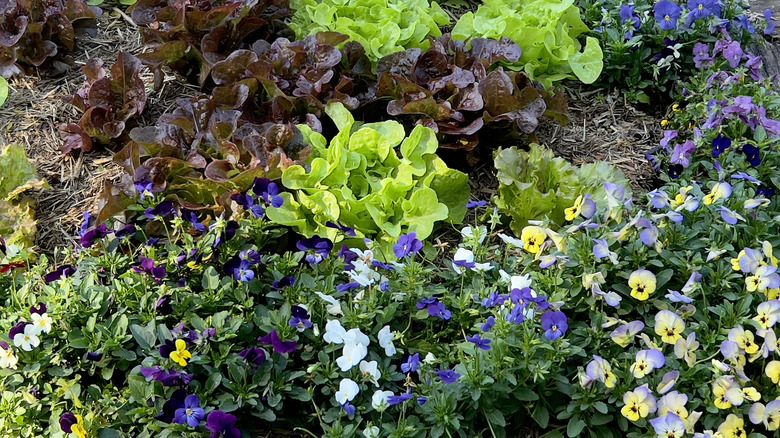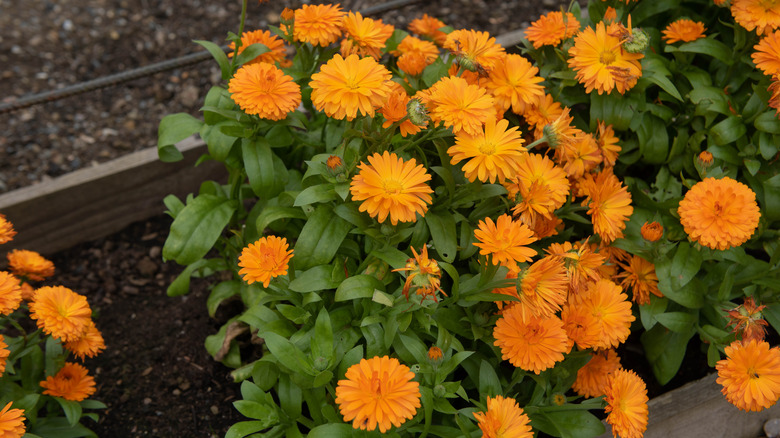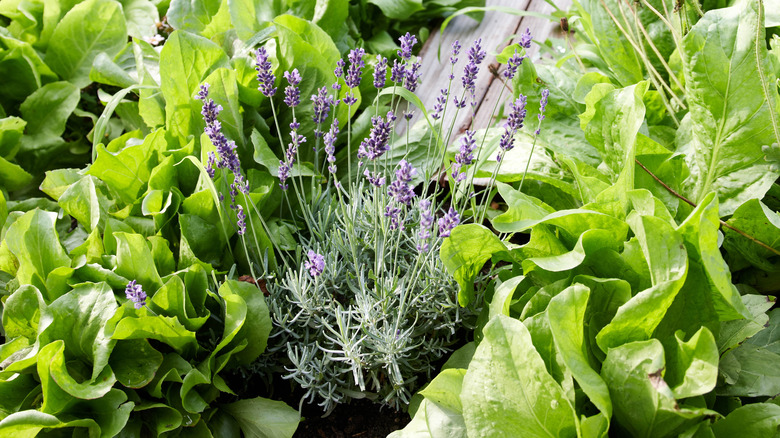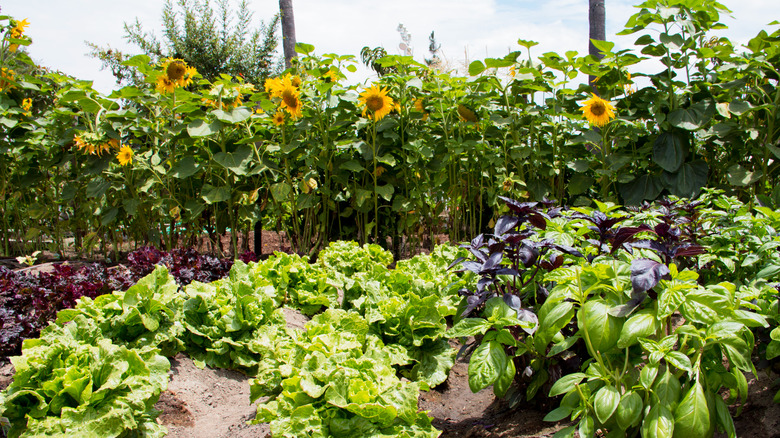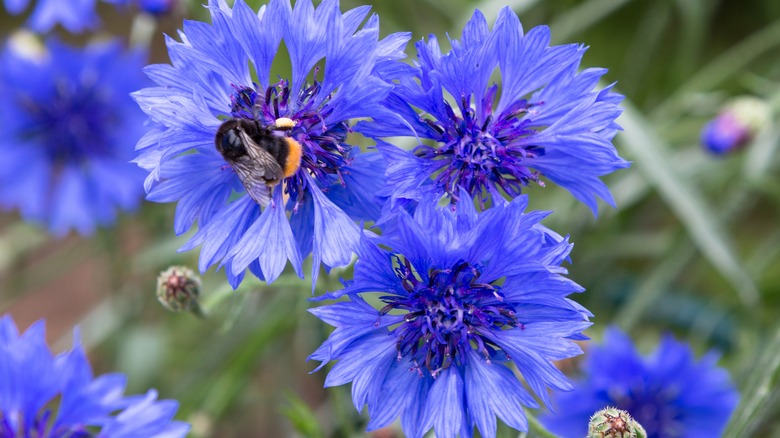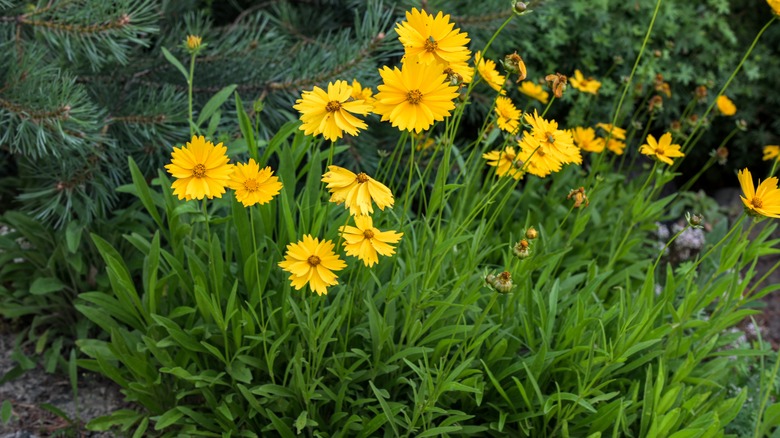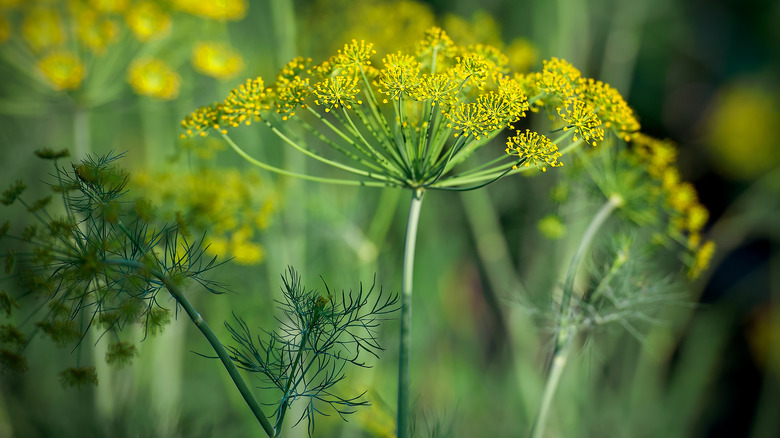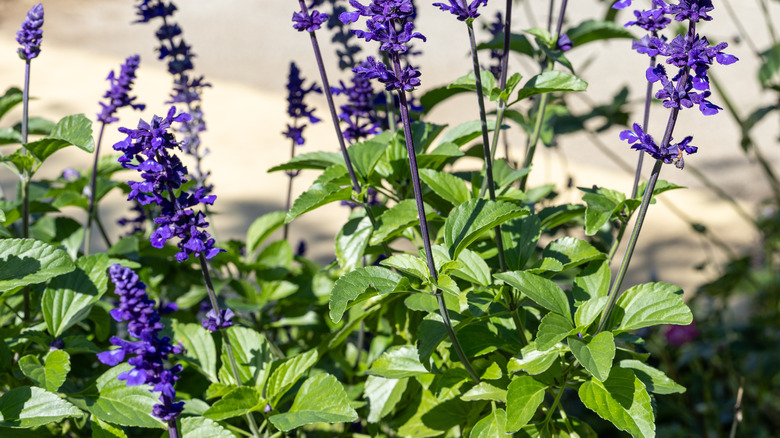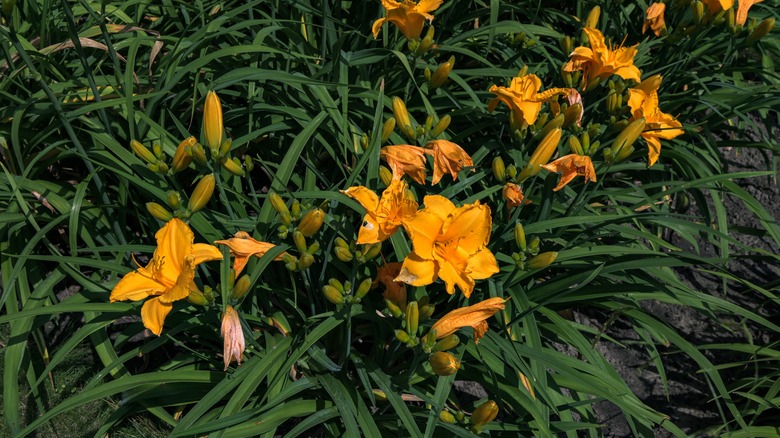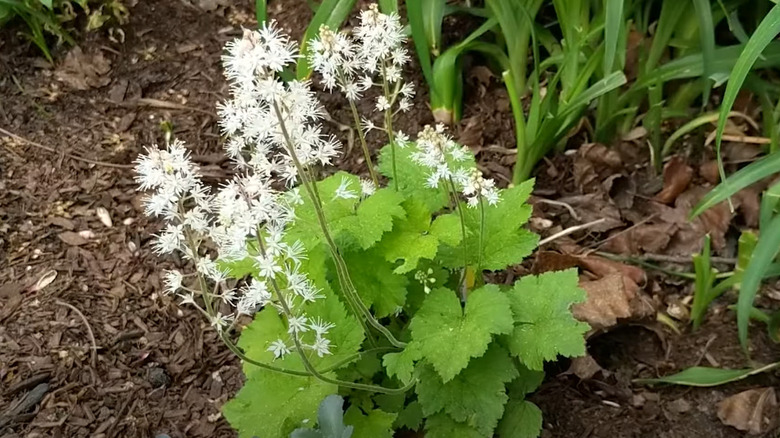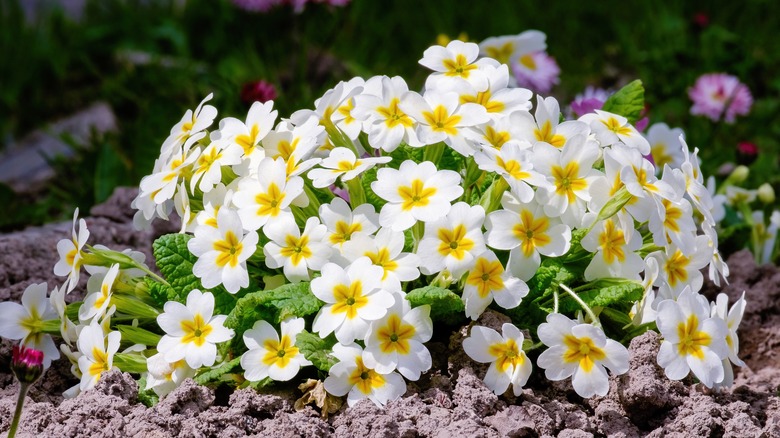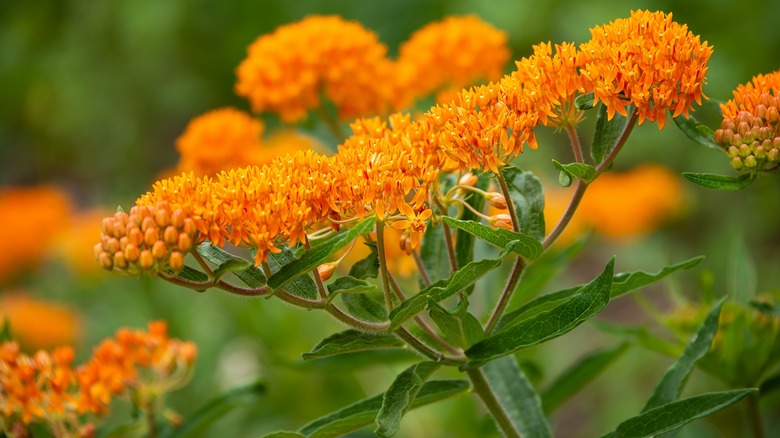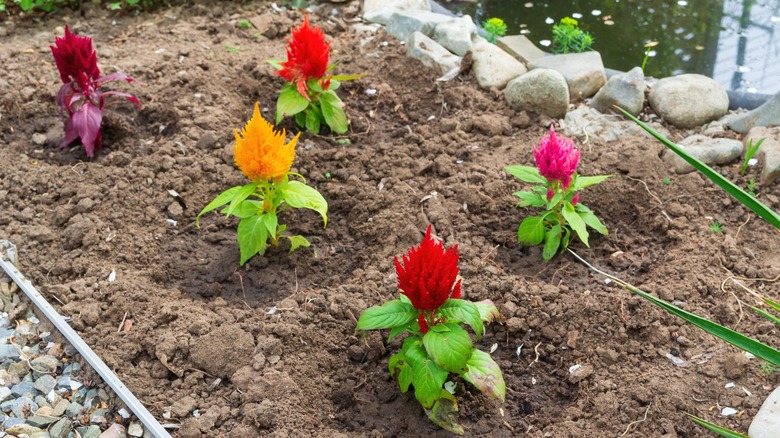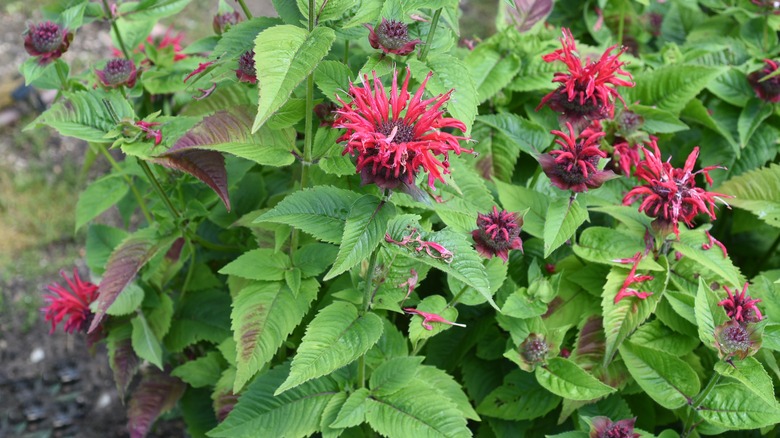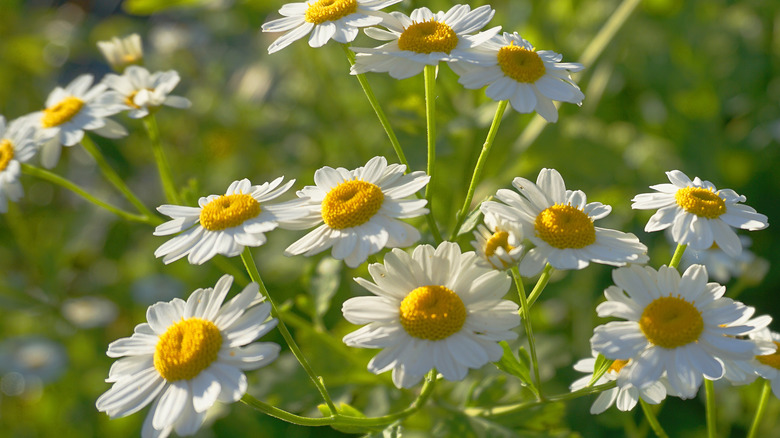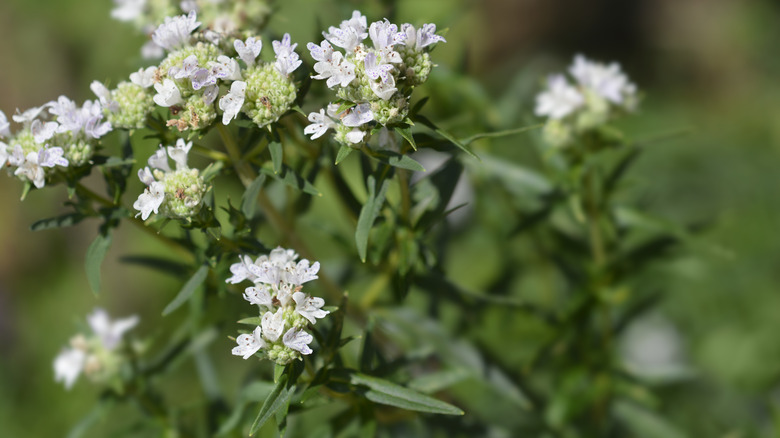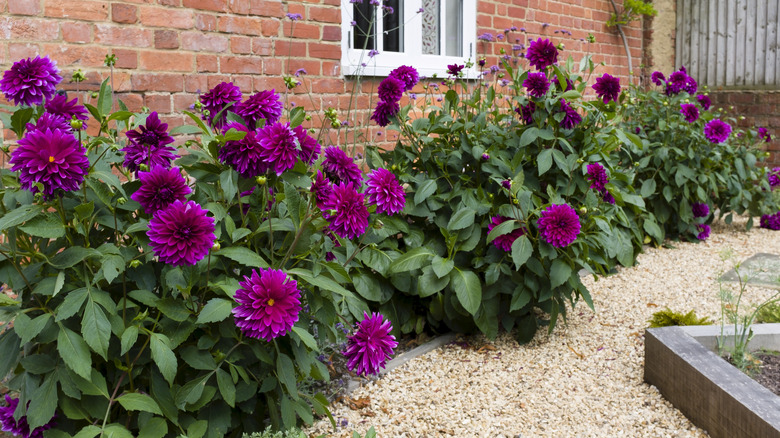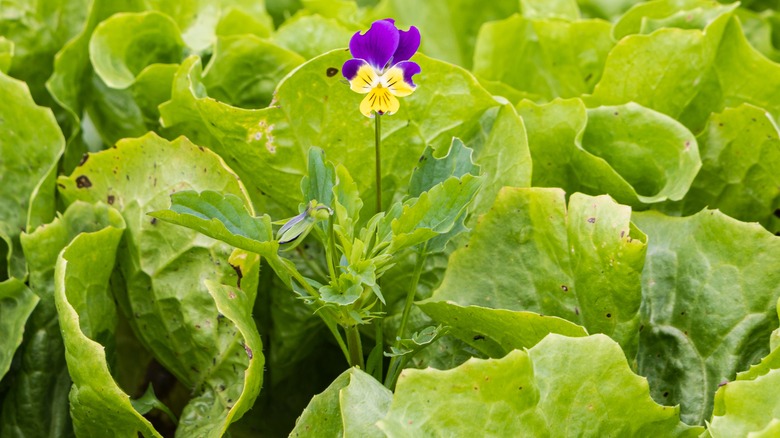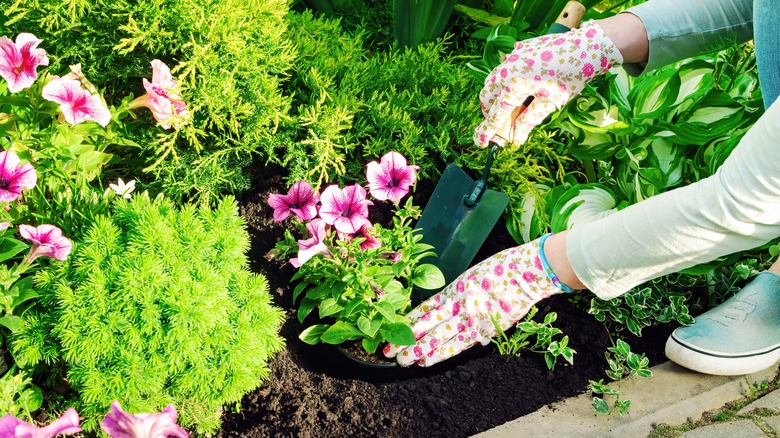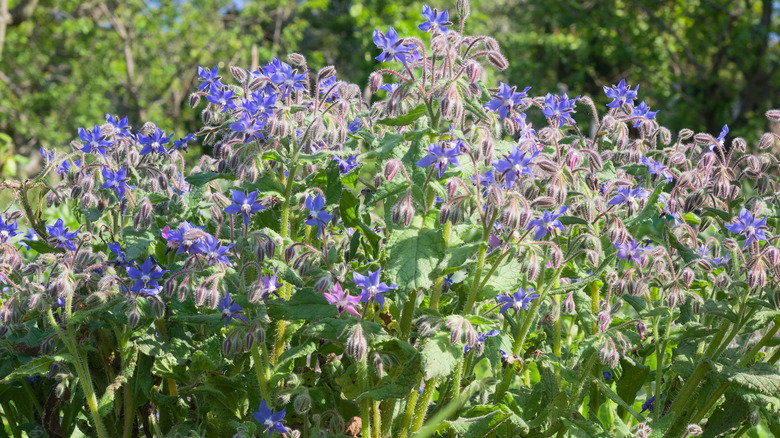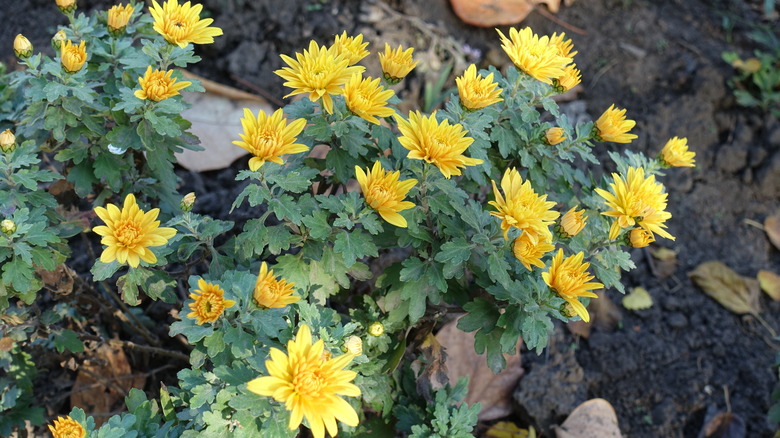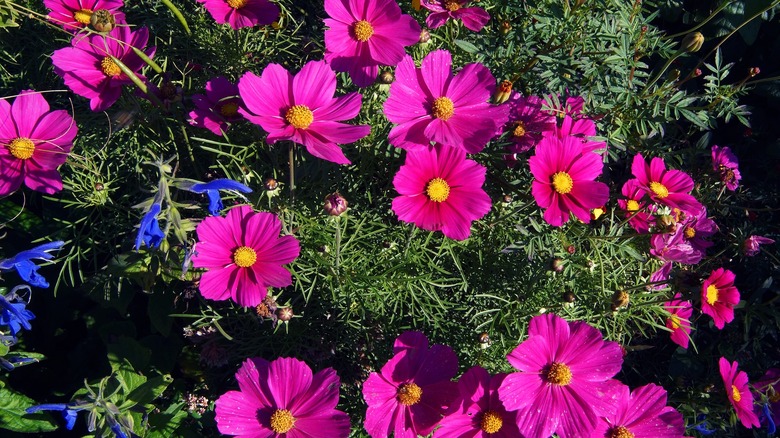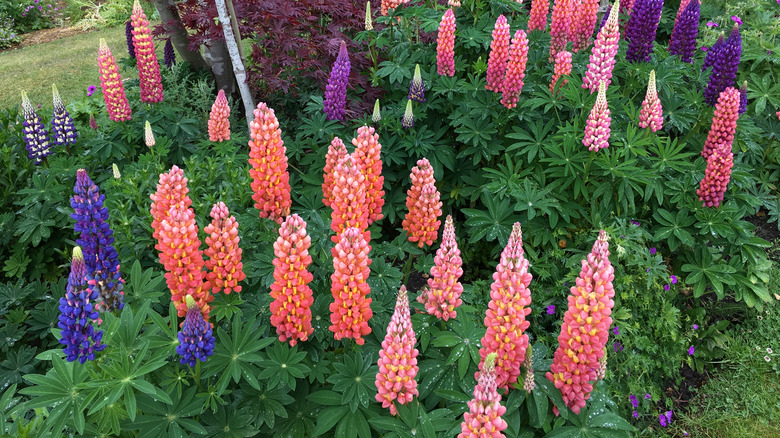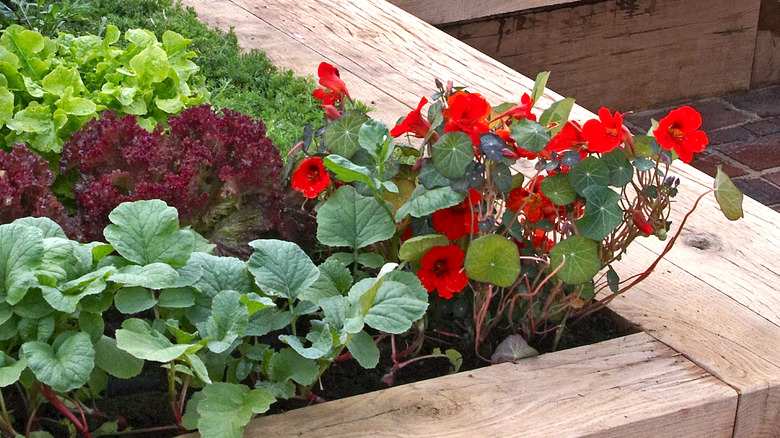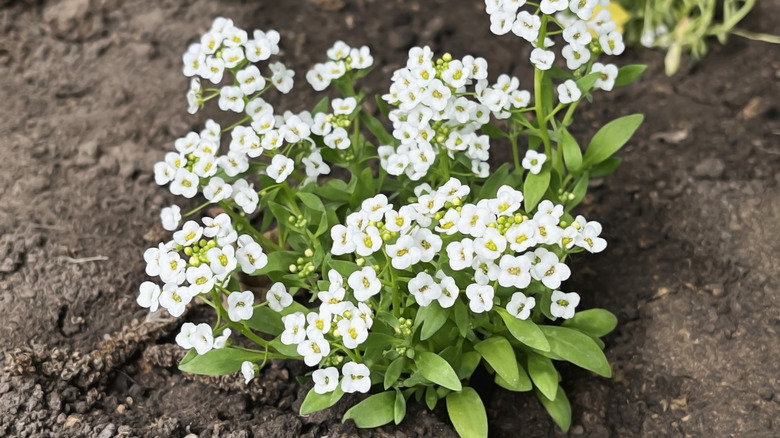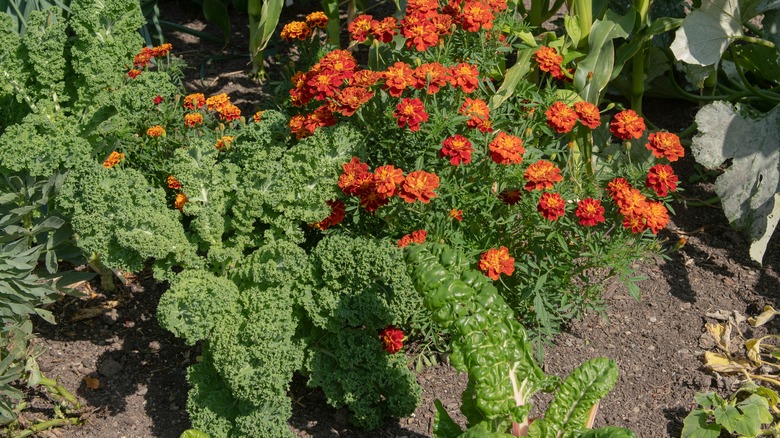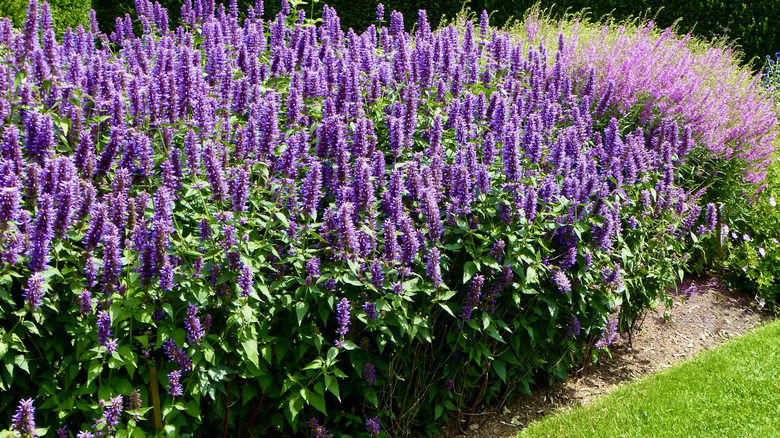26 Beautiful Flowers You Should Be Growing In Your Vegetable Garden
Isn't creating a flourishing vegetable garden gratifying? It's a rewarding change from routine visits to the grocery store to restock greens. But what if you could crank it up a notch by introducing flowers among your vegetables? Don't get it wrong, though. This isn't a mere flirtation with aesthetics, but a strategic move for a thriving garden. The right flowers, with their nectar-rich blooms, are magnets for pollinators, as well as predatory insects that feast on pests lurking around your greens. And let's not overlook the fragrant species that keep veggie thieves like deer at bay. We've rounded up 26 stunning flowers that go well with a vegetable garden — from sunflowers and nasturtiums to borage.
Speaking of specifics, take French marigolds, for instance; they're known nemeses for root-knot nematodes. Then, there are nasturtiums, which flaunt their fiery blooms while luring aphids away from your veggies, a sacrifice you'll be grateful for. However, thoughtful placement ensures harmony among your companion plants. You could alternate rows of blooms and veggies, nestle flowers within the rows of greens, or even create a blooming border around your vegetables. And remember, it's not just about the ground — consider the airspace. For example, the towering sunflowers can shield tender shade-loving lettuce and spinach from the harsh midday sun, while the sun worshippers like onions bask in unobstructed sunlight. You'll also want to sync up the planting, so those pest-busting flower varieties are flexing their muscles when your veggies are most vulnerable.
1. Calendula (Calendula officinalis)
Not only does calendula (or pot marigold) jazz up your vegetable patch with bright yellow and orange flowers, but it is also an edible wonder. This flower for vegetable gardens attracts predatory insects like lacewing and hoverflies. It thrives in sunny spots and doesn't kick up a fuss about the soil type, provided the pH hovers between 6.0 and 7.0. In spring once the danger of frost wanes, it's your cue to plant calendula, spacing transplants 8 to 12 inches apart. However, pot marigold has a bit of a wild side with its self-seeding tendencies — snip off spent flowers before they produce seeds.
2. Lavender (Lavandula)
Lavender is pretty much the Swiss Army knife of plants with all its different variants and flower shades. Beyond just looking good and smelling good, it's a great companion plant for vegetables thanks to its pest-repellant properties. Ideal for USDA zones 5 to 11, lavender does best in well-drained, somewhat sandy, and slightly alkaline soil in sunny areas. Timing is crucial when planting lavender — think post-frost in spring or give it a head start of two months before the first frost of fall, spacing them two 2 to 3 feet apart to avoid drama. Annual pruning will keep the plant from going all wild and woody.
3. Sunflowers
Sunflowers aren't just a treat for the eyes in your vegetable patch. More importantly, they serve as a natural pest control agent by attracting predatory insects like sphecid wasps and green lynx spiders. They grow well in USDA hardiness zones 2 through 11 and demand full sunlight, making them excellent neighbors in beds that receive unfiltered sun or for delicate veggies craving natural sunshades or windbreaks. To succeed with these hardy annuals, sow them in May and June in well-drained soil of pH 6.0 to 7.0. Depending on the variety, sunflowers can grow several feet tall or have a bushy spread, so choose the companion veggies wisely.
4. Cornflower
Cornflower, popular for its typically deep blue petals, is a breeze to grow across USDA zones 2 to 11, provided that the soil is well-drained. Its compatibility with vegetable plants stems from its ability to lure beneficial insects such as ladybugs and lacewings. These champs don't hog space, so planting them between your veggies won't start a brawl for nutrients. They love soaking up the sun but also tolerate a bit of shade. For summer flowering, shallowly sow your cornflower seeds come early spring among or around your vegetables, after which you thin the seedlings to 12 inches apart.
5. Tickseed (Coreopsis lanceolata)
Tickseed makes for a showstopper in April and July, splashing your garden with a bountiful of daisy-like flowers in shades ranging from yellow and orange, purple to pink. It's a magnet for insects that love to munch on destructive aphids, so your veggies thrive big time. Happiest in USDA hardiness zones 4 through 9, coreopsis favors well-drained soils of different types. Planting them as a colorful border flower in your vegetable garden is a solid move; just ensure they get full sunlight, though they won't mind some shade. Deadheading faded flowers is key to containing its aggressive self-seeding and keeping the floral show running longer.
6. Dill
Dill sports yellow flowers that attract good insects like ladybugs and parasitic wasps that feast on vegetable-eating insects we all despise. There's more, though — its fragrant foliage also excels in deterring pests. As an easy-to-grow plant, dill thrives in USDA zones 8 through 11 and prefers full sun exposure (though it appreciates a bit of shade in the summer heat cranks up). If you've got well-drained, fertile, slightly acidic soil, dill's all in. Speaking of planting dill, aim for the fall or early spring. Scatter the seeds in ¼ to ½ inch-deep rows alongside your favorite vegetables (except tomatoes). Once thinned, the remnants should be 12 inches apart.
7. Sage
Sage (or salvia) is a perennial that effortlessly elevates the vibes in a veggie garden, with pollinators like bees and butterflies going wild for its nectar-rich blossoms that can include purples, blues, reds, and even whites. Salvia sets down deep roots, living in harmony with your shallow-rooted greens without hogging nutrients. Feeling at home in USDA zones 4 through 10, sage is a flexible green companion, happy in a wide range of soil types with a sweet spot for pH 6 and 7. Plus, it's a champ in the full blaze of the sun. Come spring after frost, it's your cue to plant sage transplants started three months earlier.
8. Daylilies
Daylilies bring a splash of color with yellow, red, pink, white, orange, and purple flowers. They coexist well with vegetables, where they add visual interest and enhance biodiversity by attracting pollinators. They love nutrient-rich loamy soil and will blossom under full to partial sunlight in USDA zones 3 through 9. True to their name, their blooms unfold at sunrise and fade at sunset, with the generous number of buds guaranteeing a continuous display. The ideal planting time for daylilies is early spring, which allows their root system to establish well before winter's chill. Alternatively, plant them about six weeks before the first expected frost in fall.
9. Foam flower
Seeking a little dazzle for a shady vegetable garden? Consider foamflower, an annual that blooms in spring, giving your patch a cheerful vibe with its white and pink flowers. And bonus, it brings in insects that aid in pollination. Among the plants that can grow under thick-rooted deciduous trees, foamflower performs well in the shade in USDA zones 3 through 8. You'll also love that it doesn't ask for much and deer aren't too keen on it. But it prefers its soil like a good cake mix — moist and rich. Thinking about giving foamflowers a go in your veggies patch? Early spring or fall is the ideal planting window.
10. Primrose
Primroses steal the show in spring with blooms ranging from blue, red, white, green, to pink colors. These flowers are a favorite with bees, making them great companions for fruit-bearing vegetables like tomatoes. Content in USDA zones 4 through 8, it's pretty adaptable in partial to full shade and various soil types with slightly acidic to neutral pH levels. For the best results, transplant primroses in early spring once they've sprouted their first four leaves and developed a solid root system, spacing them about 6 to 12 inches apart. Mulching will keep your primroses happy with abundant organic matter, while deadheading ensures new blooms coming.
11. Butterfly weed
The butterfly weed (Asclepias tuberosa) is a vegetable garden's easy-going companion that lights up formerly bland patches with its vibrant orange blooms from May to August. It's a real crowd-pleaser, offering a buffet of nectar that draws hummingbirds and beneficial insects alike. The secret to success with these flowers is plenty of sunshine and sandy soil, though it will still show off in clay or gravel. Hardy across USDA zones 4 through 9 in soil with neutral to alkaline pH levels, butterfly weed is best planted as seeds during fall. It mixes nicely with various perennials and veggies.
12. Celosia
Celosia (Celosia argentea) is among the prettiest amaranth family members, with its Greek-derived name being a nod to its flame-like blooms that come in shades from yellow to red, pink, and orange. Even if it came with zero practical perks, many gardeners would choose it for the dramatic flair it adds to gardens. Plus, it's a real trooper in the face of heat and dry soils. So, if you are seeking an easy-going companion plant for summer vegetables like hot pepper, celosia could be your answer. Ideally planted in the late spring or early summer, it feels at home in sunny spots in USDA zones 10 to 11.
13. Bee Balm
Tucking some bee balm in among your veggies won't just add a pop of crimson, pink, or purple. It's also a welcome mat for those important pollinators that give your tomatoes a little love. Plus those vibrant flowers that appear from late spring to summer are a popular pick for herbal teas. This flower for vegetable gardens is a resilient sort, adapting to both wet and occasionally dry soils in hardiness zones 4 to 9, as long they get plenty of sunlight. To grow bee balms without letting them take over your garden, plant them in pots interspersed among your veggies.
14. Chamomile
Scientifically known as Matricaria chamomilla, chamomile contains small white blooms that exude an amazing fragrance that works wonders in confusing and repelling carrot flies. This easy-to-maintain annual has a long bloom season, and if paired with cabbage, it can boost their growth and flavor. Favoring a spot with full sun, chamomile thrives in well-drained soil with a pH ranging from 5.6 to 8.0. To get started, scatter the seeds in your vegetable beds in mid-spring when the soil feels warm. Snipping off wilted flowers and cutting back taller stems will keep your chamomile neat and pretty.
15. Mountain mint
Mountain mint produces flower clusters with shades of white, purple, and lavender. Unlike peppermint, mountain mint is non-invasive and can be safely nestled amidst veggies. The small, tubular flowers attract pollinators like bees and predatory insects like parasitoid wasps and ladybugs. Moreover, their pungent smell deters deer and other pests from your veggies. Mountain mint does well in hardy USDA zones 3 through 8 but with full sun to partial shade. Plus, it adapts to various soil types, provided the pH hovers between 6.0 to 8.0. Sow your seeds indoors in late winter, then plant them outdoors in spring when frost wanes.
16. Dahlia
Why not give dahlias a shot? This beauty bursts into a kaleidoscope of colors with large blooms in shades of yellow, pink, orange, white, and purple. Its ornamental value aside, the nectar-rich flowers are a magnet for bees and butterflies, boosting the pollination of the nearby veggies. Dahlias do their best in USDA Hardiness zones 2 through 11, craving well-drained fertile soil with a touch of acidity. Heads-up: Dahlia's hollow stems can struggle under the weight of the spectacular blooms or topple in the wind. Staking tall varieties will keep them standing proud amidst your vegetables.
17. Pansies
Coming in a range of colors (think blue, violet, white, orange, gold, maroon), pansies will give your vegetable garden a bit of a facelift while inviting pollinators. They are early risers, popping their blossoms in early spring. Settle them in well-drained, sandy loam soils in USDA zones 8 to 11 spots receiving full to partial sunshine and they'll be good to go. The ideal time to sow the seeds is in July or August. Or for a quicker route, plant seedlings in September, giving each 7 to 12 inches of elbow room. Overwatering is a common mistake that will kill your pansies, so be judicious.
18. Petunias
Petunias are a riot of colors with trumpet-shaped flowers that offer various possibilities for garden decoration and design. They bloom non-stop from spring until the first frost and invite bees and butterflies, boosting pollination and biodiversity in your garden. Not to mention, they emit smells and compounds that keep destructive vegetable pests like tomato hornworms, asparagus beetles, and aphids at bay. Petunias like their soil moist and well-draining in USDA zones 10 and 11. To grow these flowers with vegetables, hold your horses until the frost wanes and the soil gets warm in spring.
19. Borage
Borage (or Borago officinalis if you want to get scientific) is a hardy annual that favors spots with full sun and partial shade and produces showy blue flowers that bring along pollinators. Hornworms can't stand borage, making it a good companion plant for tomatoes. Not to forget that it enriches the soil with trace minerals, giving your veggies a little growth spurt. It isn't as picky about growing conditions, too — it's happy in well-draining slightly acidic, neutral, or alkaline soil in USDA zones 2 through 11. For the best results, plant borage saplings or seeds in spring, each with 6 to 12 inches of breathing room.
20. Hardy mums
Another flower to grow with vegetables, hardy mums bring with them a splash of color and pollinators with lively blooms of yellow to fiery red in the fall. They love soaking up the sunshine in USDA zones 5 to 9 and perform well when planted in spring (post-frost) in well-drained soil with a slightly acidic pH. While mostly resilient, a few chrysanthemums need additional protection to weather the winter. Trimming shoots not longer than 6 inches a couple of times between late May and late June will keep your hardy mums looking good.
21. Cosmos
Towering up to 6 feet, cosmos is a flashy bloomer that flaunts daisy-esque flowers that vary from maroon to white and act like a magnet for bees and butterflies around your fruiting veggies. But there's more than meets the eye, as it also lures parasitic wasps and lacewings that feast on pesky critters. These beauties are happiest in well-drained, nourishing, and mildly acidic to alkaline soils across USDA zones 2 through 11. However, it doesn't mind not-so-perfect soil conditions. Scatter cosmos seeds in your vegetable patch once the frost wanes, and space the seedlings around 1.5 feet apart. Mature cosmos plants will benefit from staking.
22. Lupines
Ah, lupines! These majestic flowers tower above the garden crowd, parading their elongated, densely packed floral clusters of varying colors when spring and summer grace us. Beyond elevating garden aesthetics, the true superpower of lupines is adding nitrogen to the soil, a capability that nitrogen-hogging vegetables like cabbage cherish. If seeking to incorporate lupines into your vegetable patch, plant the dwarf varieties in spring or early summer. They prefer a daily sunshine dosage of two to six hours along well-drained, slightly acidic soil, ideally in USDA zones 4 through 8. Give them alkaline, heavy clay, or soggy soil, and they won't stick around for long.
23. Nasturtium
Rocking a range of flower shades like yellow, red, pink, and orange, nasturtium boosts the flavor of radishes and cabbage while also tempting aphids, snails, and slugs away from veggies. They are sun worshippers, but they appreciate a bit of shade when the summer heat cranks up. Interestingly, they are pretty low-maintenance, preferring poor soils, given that too many nutrients make them go all out on the leaves at the expense of those funky flowers you want. Kickstart nasturtium seeds indoors 1 to 1.5 months before the last frost or plant them straight in your garden in late spring or when summer rolls around.
24. Alyssum
The low-growing alyssum is a terrific choice for lining your veggie plot's edges. Its continuous, nectar-filled summer blooms don't just win hearts and attract pollinators. They are also a VIP invite for ladybugs and hoverflies, nature's pest control squad that targets veggie-munching insects like aphids. Plus, you can count on its dense growth to fend off weeds. While sweet alyssum adapts to various soil types, it shows its best performance in moist, well-draining soil in USDA zones 5 through 9. For the best results, plant it a few weeks before the last frost waves goodbye — it's a cool-season annual, after all.
25. French marigold
Imagine the sunset hues of French marigolds peppering your vegetable garden and inviting predatory insects like parasitic wasps and hoverflies, all without asking much from you. However, their magic isn't all above the ground. Beneath the soil, these flowers release a chemical that suppresses root-knot nematodes, giving your veggies a conducive environment. Pretty versatile, these sun-lovers rock it in slightly acidic to mild alkaline, well-drained soils of various types in USDA zones 2 to 11. Kick things indoors with seeds 1.5 to 2 months pre-last frost, then move the saplings into your vegetable patch once the danger of frost is over.
26. Blue giant hyssop
Wrapping up our roundup of beautiful flowers to grow with vegetables is the show-stopping blue giant hyssop. It's a long bloomer, showing off blue-purple spikes that serve as a hotspot for pollinators like hummingbirds and bees and boost the yield of fruit-bearing veggies like tomatoes. Not to mention it's generally pest and disease-free. Happy in sunny areas across USDA zones 5 through 9, this perennial beauty likes to dig its roots into sandy or loamy soils that drain well. Sow the seeds along the perimeter of your vegetable garden post-last frost and come early spring, and a quick trim will ensure your flower bushes out nicely in summer.
